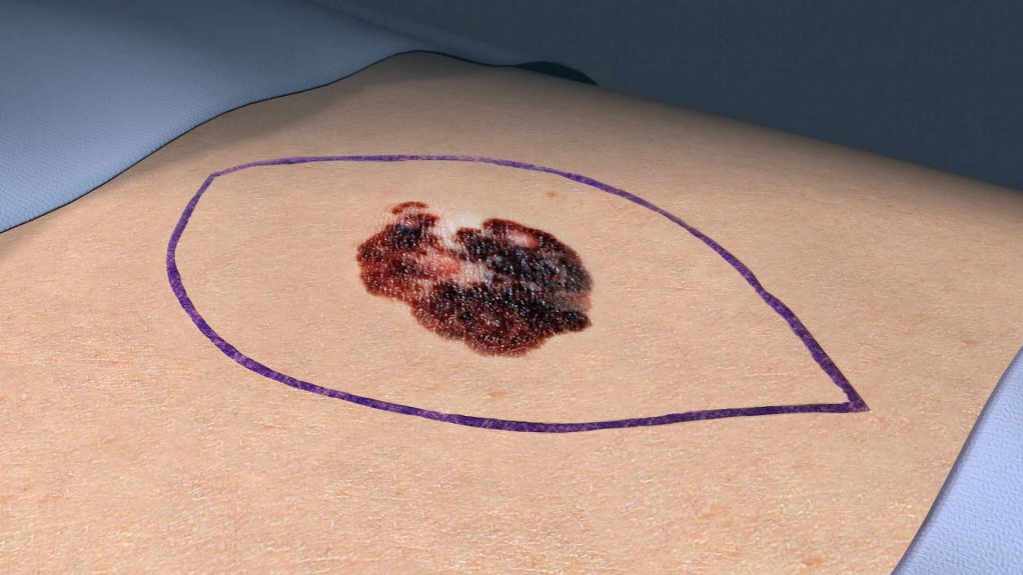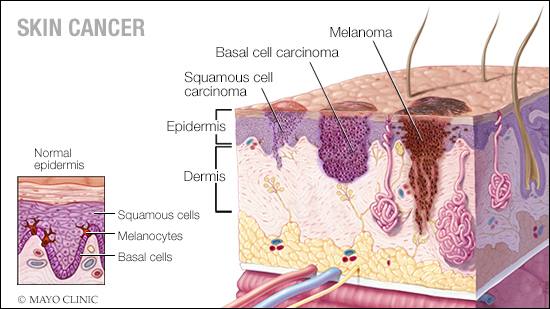
Skin cancer is the most common form of cancer. When treated early, it’s also the most curable type of cancer. Mohs surgery is one of the most successful surgical treatments for removing skin cancer.
The abnormal growth of skin cells that leads to skin cancer develops most often on skin exposed to the sun, such as your scalp, face, lips, ears, neck, arms and hands. However, it can also occur on areas of your skin not directly exposed to sunlight, including your palms and beneath your fingernails or toenails.
Types of skin cancer
Basal cell carcinoma, squamous cell carcinoma and melanoma are three of the most common types of skin cancer. Of those three types, basal cell and squamous cell skin cancers are diagnosed most often and are the most curable.
Basal cell carcinoma — This type of skin cancer often starts as a small, flesh-colored or pearly-looking bump on the skin. It may bleed or have no symptoms. It may look like a pimple that doesn’t entirely heal. Basal cell carcinoma may extend deep into the tissue under the skin.

Squamous cell carcinoma — This type of skin cancer often starts as a rough or scaly patch or growth on the skin. It can develop rapidly and hurt a bit if touched. Squamous cell carcinoma usually appears in one place on the skin and rarely spreads to other parts of the body. However, if left untreated, this cancer may grow within the skin and destroy surrounding tissues and structures, such as nerves and muscles. The cancerous cells can then spread to nearby lymph nodes and other areas.
Melanoma — While melanoma occurs less commonly, it’s more serious. It often begins as a dark spot or odd-looking mole. It can grow deep into the tissue under the skin. If left untreated, melanoma can spread to other parts of the body. Early detection and treatment of this cancer are critical.
Treating skin cancer with Mohs surgery
Mohs surgery is intended to remove all the cancerous tissue, called a tumor, and leave as much healthy neighboring skin and tissue as possible.
To diagnose skin cancer, a healthcare professional removes a biopsy, or small tissue sample, to be examined. While you can see the top of the tumor growing on the skin’s surface, deeper roots may be out of sight under the skin. The method used during Mohs surgery looks closely at the affected area and surrounding skin to find and remove all of the tumor.
A Mohs surgeon may recommend this procedure for skin cancer that:
- Has come back after previous treatment or has a high risk of recurring.
- Has developed rapidly and deeply.
- Is located around the face, scalp or neck.
What to expect with Mohs surgery
Mohs surgery is an outpatient surgery, meaning you won’t stay in the hospital overnight. The length of the surgery depends on the size and number of tumors to be removed. While surgery can last between one to 10 hours, most surgeries take two to five hours.
During Mohs surgery, the area of your skin is numbed first. Then, the surgeon removes the tumor and a thin layer of skin around it. After any bleeding is stopped, a temporary bandage is applied. These steps typically take about 10 minutes.
While you wait in the surgical waiting room, the surgeon maps each section of tissue from the tumor that was removed and uses a microscope to examine it for cancer cells. If the surgeon finds cancer cells, the map helps to locate the position in the skin.
You’ll return to the surgical room for the surgeon to remove more tissue from the area where the cancer cells are found. These steps are repeated until the surgeon no longer sees cancer cells under the microscope.
After the tumor is completely removed, the surgeon determines the best option for closing the wound area, including:
- Side-to-side stitches — Most surgeries are closed this way with a row of sutures if enough loose skin is available next to the wound.
- Skin graft — The surgeon may remove a piece of skin from another part of your body to place over the wound.
- No stitches — The wound may be left open to heal on its own, depending on the area of the body.
- Cartilage harvest — Cartilage is a connective tissue found in the nose and ear. Your surgeon may take cartilage from one of these areas to repair and support the wound.
- Skin flap — If your wound is too large to close with side-to-side stitches, a skin flap is used to move nearby skin to cover it.
After surgery, your surgeon may prescribe an antibiotic to lower the risk of infection in the wound. Follow instructions from your care team for managing pain. Depending on the location and size of the wound, each person may have a different level and time frame for pain.
Healing time also depends on the size of the wound and the way it was closed. The procedure can cause scarring, which will typically soften naturally over time.
After having skin cancer once, you are at a higher risk of having a recurrence of the same type of cancer or another type of skin cancer. Talk with your healthcare team about how frequently you need full-body skin examinations.
Watch: How Mohs surgery is used to treat skin cancer
John Kohorst, M.D., is a dermatologist and Mohs surgeon in La Crosse and Onalaska, Wisconsin.
